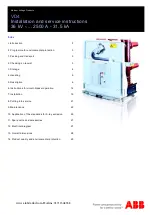
I.B. 3A74792H08
Page 41
Effective
09/2014
The recommendations and information contained
herein are based on Eaton experience and judgment,
but should not be considered to be all-inclusive or
covering every application or circumstance which may
arise. If further information is required, you should
consult Eaton.
Testing Procedures:
Assuming that the breaker is
safely pulled out to the Test/Disconnect position in the
enclosure or placed on the workbench, follow this
procedure to perform the CloSure
TM
Test. For further
instructions on disconnecting the circuit breaker consult
Section 4 of this manual. If the enclosure is equipped
with the MOC operating in the test position also, make
certain that the MOC is connected to operate.
Step 1 -
On the front cover identify the status indicators.
MAKE SURE THE CLOSING SPRING STATUS
INDICATES
“Di sch arg ed”
AND THE MAIN
CONTACT INDICATOR SHOWS
“Open”
(Figure
6-7
).
Step 2 -
Remove the circuit breaker front cover.
Be sure
to save the original fasteners for reassembly.
Step 3 -
Cut a piece of one inch wide drafting/masking
tape approximately 8 to 10 inches long.
Step 4 -
Place the tape around the cam starting from the
bottom up. Make certain that the tape adheres well to
the cam surface. (See Figures
6-8, 6-9
and
6-10).
Step 5 -
Mount the transparent CloSure
TM
Test Tool
with two bolts and washers. Refer to Figures
6-21, 6-22
and Table
6.3
for appropriate mounting holes. Hand
tighten the bolts (Figures
6-11, 6-12, 6-21
and
6-22
).
Step 6 -
A Sanford
®
Sharpie
®
black fine point permanent
marker, item no. 30001, is recommended for this next
step. Place the marker tip in the proper hole
(“C”
). Refer
to Figure
6-21
and make a heavy mark on the tape as
shown in Figure
6-14.
Figure 6-10 Attaching Tape Around to Back of Cam
Step 7 -
Charge the closing springs with the
maintenance tool. Continue charging the closing
springs until a “click” is heard and the status indicator
shows
“Charged”
(Figure
6-13
).
Step 8 -
While holding the marker tip on the tape,
close the breaker (Figure
6-14
).
Step 9 -
Move the marker back and forth horizontally
approximately 15
o
in both directions to create a line
on the tape that identifies the closed rest position
(Figures
6-15, 6-21
and
6-17B.
Figure 6-11 AttachingCloSure
TM
Test Tool at Hole “A”
Figure 6-12 Attaching CloSure
TM
Test Tool at HPole “B”
Figure 6-13 Manually Charging Closing Springs
Summary of Contents for 380 VCP-W 21
Page 2: ......
Page 13: ...I B 3A74792H08 Page 7 Effective 09 2014 ...
Page 22: ...Page 16 I B 3A74792H08 Effective 09 2014 Figure 3 7 Typical VCP W 38kV Escutcheon ...
Page 23: ...I B 3A74792H08 Page 17 Effective 09 2014 Figure 3 8 Typical VCP W 38kV Escutcheon ...
Page 33: ...I B 3A74792H08 Page 27 Effective 09 2014 compartment Figure 5 5 Charging Schematic ...
Page 38: ...Page 32 I B 3A74792H08 Effective 09 2014 Figure 5 10 Undervoltage Trip Device Configuration ...
Page 60: ...Page 54 I B 3A74792H08 Effective 09 2014 ...
Page 62: ...Page 56 I B 3A74792H08 Effective 09 2014 Style 3A74792H08 Printed in USA ...
















































